German Autobahns
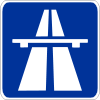

The Autobahns are the nationally coordinated motorway system in Germany. In German, they are called Bundesautobahn (plural Bundesautobahnen, abbreviated BAB), which translates as federal motorway. German autobahns have no general speed limit (though about 60% of the total length is subject to local and/or conditional limits), but the maximum recommended speed is 130 km/h (80.8 mph).
Contents |
Construction
Similar to such motorways in other countries, autobahns have multiple lanes of traffic in each direction, separated by a central barrier with grade-separated junctions and access restricted to motor vehicles with a top speed of at least 61 km/h. The first German Autobahn was completed in 1932 between Cologne and Bonn [1]. Each carriageway was flanked by shoulders about 60 cm in width, constructed of varying materials; right-hand shoulders on many autobahns were later retrofitted to 120 cm in width when it was realized cars needed the additional space to pull off the autobahn safely. In the postwar years, a thicker asphaltic concrete cross-section with full paved hard shoulders came into general use. The top design speed was approximately 160 km/h in flat country but lower design speeds could be used in hilly or mountainous terrain. A flat-country autobahn constructed to published design standards in use during the Nazi period could support speeds on curves of about 150 km/h.
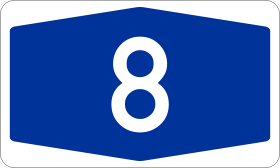
The current autobahn numbering system in use in Germany was introduced in 1974. All autobahns are named by using the capital letter A, which simply stands for "Autobahn" followed by a blank and a number (for example A 8). The "main autobahns" going all across Germany have a single digit number. Shorter autobahns that are of regional importance (e.g. connecting two major cities or regions within Germany) have a double digit number (e.g. A 24, connecting Berlin and Hamburg). The system is as follows:
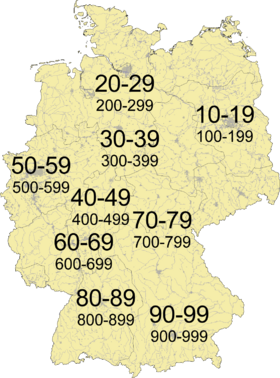
- A 10 to A 19 are in eastern Germany (Berlin, Saxony-Anhalt, parts of Saxony and Brandenburg)
- A 20 to A 29 in northern and northeastern Germany
- A 30 to A 39 in Lower Saxony (northwestern Germany)
- A 40 to A 49 in the Rhine-Ruhr Area
- A 50 to A 59 also in the Rhine-Ruhr Area
- A 60 to A 69 in Rhineland-Palatinate, Saarland and Hesse
- A 70 to A 79 in Thuringia, northern Bavaria and parts of Saxony
- A 80 to A 89 in Baden-Württemberg
- A 90 to A 99 in (southern) Bavaria
There are also very short autobahns of just local importance (e.g. beltways or the A 555 from Cologne to Bonn) that usually have three numbers, the first one of which is similar to the system above, depending on the region. East-west routes are always even-numbered, north-south routes are always odd-numbered.
In general autobahns with odd numbers go from north to south, the higher the number, the more to the east they are located. Those autobahns having even numbers go from west to east, the higher their number, the further it is located to the south.
History
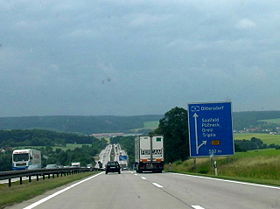
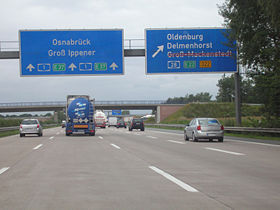
The idea for the construction of the Autobahn was first conceived during the days of the Weimar Republic, but apart from the AVUS in Berlin, construction was slow, and most projected sections did not progress much beyond the planning stage due to economic problems and a lack of political support. One project was the private initiative HaFraBa which planned a "car only road" (the name autobahn was created in 1929) crossing Germany from Hamburg in the North via central Frankfurt am Main to Basel in Switzerland. Parts of the HaFraBa were completed in the 1930s and early 1940s, but construction eventually was halted by World War II.
Just days after the 1933 Nazi takeover, Adolf Hitler enthusiastically embraced an ambitious autobahn construction project and appointed Fritz Todt the Inspector General of German Road Construction. Soon, over 100,000 labourers worked at construction sites all over Germany. As well as providing employment and improved infrastructure, necessary for economic recovery efforts, the project was also a great success for propaganda purposes. In retrospect, one can say another aim of the autobahn project, beyond creating national unity and strengthening centralised rule, was to provide mobility for the movement of military forces (see Nazi architecture).
The autobahns formed the first limited-access, high-speed road network in the world, with the first section from Frankfurt am Main to Darmstadt opening in 1935. This straight section was used for high speed record attempts by the Grand Prix racing teams of Mercedes-Benz and Auto Union until a fatal accident involving popular German race driver Bernd Rosemeyer in early 1938.
Development of the overall length (at the end of):
- 1935
- 108 km
- 1936
- 1 086 km
- 1937
- 2 010 km
- 1938
- 3 046 km
- 1939
- 3 300 km
- 1940
- 3 736 km
| Year | 1950 | 1955 | 1960 | 1965 | 1970 | 1975 | 1980 | 1985 | 1990 |
| Length in km | 2.128 | 2.187 | 2.551 | 3.204 | 4.110 | 5.742 | 7.292 | 8.198 | 8.822 |
| Year | 1995 | 1996 | 1997 | 1998 | 1999 | 2000 | 2001 | 2002 | 2003 | 2004 | 2005 |
| Length in km | 11.143 | 11.190 | 11.246 | 11.309 | 11.427 | 11.515 | 11.712 | 11.786 | 12.037 | 12.044 | 12.174 |
During World War II, the central reservation of some autobahns were paved to allow their conversion into auxiliary airports. Aircraft were either stashed in numerous tunnels or camouflaged in nearby woods. However, for the most part, the autobahns were not militarily significant. Motor vehicles could not carry goods as quickly or in as much bulk as trains could, and the autobahns could not be used by tanks as their weight and caterpillar tracks damaged the road surface. The general shortage of gasoline in Germany during much of the war, as well as the low number of trucks and motor vehicles badly needed for direct support of military operations, further decreased the autobahn's significance. As a result, most military and economic freight was carried by rail. After the war, numerous sections of the autobahns were in bad shape, severely damaged by heavy Allied bombing and military demolition. Furthermore, thousands of kilometers of autobahns remained unfinished, their construction brought to a halt by 1943 due to the increasing demands of the war effort. [2] [3]
In West Germany most existing autobahns were soon repaired after the war. During the 1950s, the West German government restarted the construction programme. It invested in new sections and in improvements to older ones. The finishing of the incomplete sections took longer, with some stretches opened to traffic in the 1980s. Some sections cut by the Iron Curtain in 1945 were completed after German reunification in 1990. Some sections were never completed, as more advantageous routes were found. Some of these sections stretch across the landscape forming a unique type of modern ruin, often easily visible on satellite photographs.
The autobahns in East Germany (GDR) and the former German provinces of East Prussia, eastern Pomerania and Silesia in Poland and the Soviet Union after 1945 were grossly neglected in comparison to those in West Germany and Western Europe in general. They received minimal maintenance during the years of the Cold War. The speed limit on the GDR autobahns was 100 km/h, however lower speed limits were frequently encountered due to the poor condition of the road, changing quickly in some instances. The speed limits on the GDR autobahns were rigorously enforced by the Volkspolizei, whose patrol cars were frequently encountered hiding under camouflage waiting for speeders. In the 1970s and 80s, the West German government paid millions of Deutsche Marks to the GDR for construction and maintenance of the transit autobahns between West Germany and West Berlin, although there were indications that the GDR diverted some of the maintenance funds for other purposes.
Current density

Today, Germany's autobahn network has a total length of about 11,980 km (as of January 1, 2003), third longest after the United States' Interstate Highway System and the National Trunk Highway System (NTHS) of the People's Republic of China.
Many sections of Germany's autobahns are modern, containing three lanes in addition to an emergency lane. Some other sections remain in their original state, with two lanes, no emergency lane, short slip-roads / ramps, etc. Such a combination of the two types of autobahn can be seen on the A 9 autobahn (Munich-Berlin). Heading out from Munich, the autobahn starts off as a modern, five lane in each direction + emergency lane autobahn. However, after heading into Thuringia, which was formerly part of East Germany, parts of the autobahn are no wider than two lanes and no emergency lane exists (only rare emergency bays with a telephone post in orange-yellow). Ongoing roadworks will eventually bring the entire A 9 to three-lane standard. Another large project involves the extension of the A 6 at its eastern end to connect Nürnberg/Amberg with the Czech motorway D 5 running from Rozvadov to Prague.
Speed limits

A hard limit is imposed on some vehicles:
| 60 km/h |
|
|---|---|
| 80 km/h |
|
| 100 km/h |
|
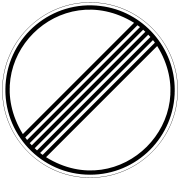
The German autobahns are famous for being some of the few public roads in the world without blanket speed limits for cars and motorcycles. Lack of blanket speed limits does not appear to negatively impact the road safety of autobahns compared with motorways in other countries; motorways are safer than other road types. Perhaps this is in part because traffic can be heavy enough to restrict speeds to little above the typical motorway speeds found elsewhere, or due to reducing the exhaustion of the drivers by shortening their travelling times. Certainly, speed limits do apply at junctions and other danger points, like sections under construction or in need of repair. Speed limits at non-construction sites are generally 100 km/h, 120 km/h, or sometimes even 130 km/h; construction sites have a usual speed limit of 80 km/h but may be as low as 60 km/h or even 40 km/h. Certain stretches have separate, and lower, speed limits used in cases of wet lanes.
Some limits were imposed to reduce pollution and noise. Limits can also be put into place temporarily through dynamic traffic guidance systems that display the according traffic signs. If there is no speed limit, the recommended speed limit is not more than 130 km/h, referred to in German as the Richtgeschwindigkeit; this speed is not a binding limit, but being involved in an accident driving at higher speeds can lead to being deemed at least partially responsible due to "increased operating danger" (Erhöhte Betriebsgefahr). The average rate of speed traveled on the autobahn in unregulated areas by automobiles not regulated by other laws is about 150 km/h. On average, about half of the total length of the German autobahn network has no speed limit, about one third has a permanent limit, and the remaining parts have a temporary limit for a number of reasons.
In places without a general limit, there are mostly also no restrictions on overtaking (save for the general prohibition to overtake on the right side). Therefore, those traveling at high speeds may regularly encounter trucks running side-by-side at only about 80 km/h. In theory, trucks are not allowed to overtake others unless they drive 20 km/h faster than whomever they are overtaking, but truck drivers are generally under pressure to arrive in time, and such laws are rarely enforced for economic and political reasons, as many trucks are from foreign countries. The right lane of a typical autobahn is often crowded with trucks, and too often, trucks pull out to overtake. Due to size and speed this is often referred to as "Elefantenrennen" (Elephant Race). In some zones with only two lanes in both directions there is no speed limit, but a special overtaking restriction for trucks and/or cars pulling trailers. (An exception is Sundays and national holidays, on which trucks usually are not allowed to drive before 22:00 h, except for trucks carrying perishable goods and certain other exceptions such as military vehicles.)
Powerful modern cars can easily reach speeds well over 230 km/h, and most large car manufacturers follow a gentlemen's agreement by electronically limiting the top speed of their cars to 250 km/h for safety reasons (inexperienced drivers and risk of tires failing, especially when underinflated). Yet, these limiters can technically be defeated, so speeds over 300 km/h are not uncommon. But due to common speed limits and other traffic, such speeds are rarely attainable. Most unlimited sections of the autobahn are located outside of urban and densely populated areas. The A 8 between Stuttgart and Munich is one such example, the A 4 between the metropolitan area of Chemnitz-Zwickau and Dresden as well. The A 81 between Stuttgart and Singen (Bodensee) is another beautiful example. The largest part of this route has no speed limit (about 150 km).
Vehicles unable to attain speeds in excess of 60 km/h are not allowed to use the autobahn. Though this limit is not high for most modern vehicles, it prevents very small cars (e.g. quads) and motor-scooters (e.g. Mofas) from using autobahns. To comply with this limit, several heavy-duty trucks in Germany (e.g. for carrying tanks or cranes) have a design speed of 62 km/h (usually denoted by a round black-on-white sign with "62" on it).
The overall safety record of autobahns is comparable to other European motorways and motorways are safer than other road types. A 2005 study by the Federal Minister of the Interior indicated there were an equal number of accidents per mile on the autobahn in sections without any speed limits.
Toll roads
A recent development involves the introduction on January 1, 2005 of mandatory tolls (Mautpflicht) for heavy trucks (weighing more than 12 t) while using the German autobahn system. The German government contracted with a private company, Toll Collect GmbH, to operate the toll collection system, which involves the use of vehicle-mounted transponders and roadway-mounted sensors installed throughout Germany. The introduction of this system experienced several technical delays resulting in the loss of millions of Euros in potential revenue to the government. One result of the new toll policy has been an increase in heavy truck traffic on regular highways (Bundesstraßen and Landstraßen) in order to avoid paying tolls. There have been recent discussions about extending the toll requirement to include passenger cars, however this has proven so far to be very unpopular with a majority of the public and politicians of the major parties have denied they are considering such measures.
Traffic laws and enforcement
The German autobahn network is patrolled by unmarked police cars and motorcycles equipped with video cameras; this allows the enforcement of laws (such as tailgating) which are often viewed in other countries as difficult to prove in court. Notable laws include the following.
- Autobahns may only be used by powered vehicles that are designed to achieve a maximum speed exceeding 60 km/h, or more than 35 MPH.
- Similar to traffic laws in the U.S., the right lane must be used when it is free (Rechtsfahrgebot) and the left lane(s) is (are) generally intended for overtaking only; drivers using the left lane for prolonged periods of time when the other lanes are free could be fined by the Autobahnpolizei.
- Forcing slow drivers on the left-hand lane to change the lane (even if they are occupying it illegaly) by flashing or tailgaiting may be considered coercion.
- Overtaking on the right (undertaking) is strictly forbidden, except in traffic jams where it may be practiced with caution. Up to a speed of 60 km/h it is permitted to pass cars on the right side if the speed difference is not greater than 20 km/h or the vehicle on the left lane stands still. This is not anymore called overtaking, but driving past. Even if the car overtaken is illegally occupying the left-hand lane, it is not an acceptable excuse; in such cases the police will routinely stop and fine both drivers.
- In the case of a traffic jam, drivers have to form an emergency lane to guarantee that emergency services can reach the scene of the accident. This lane has to be formed between the left lane and the lane next to the left lane.
- It is unlawful to stop for any reason except for emergencies and when unavoidable, like traffic jams or being involved in an accident. This includes stopping on emergency lanes. In some cases (if there is danger to life and limb or property e.g. cars and highway infrastructure) it can also be a crime and the driver could receive a prison sentence (up to 5 years).
- The distance to the vehicle in front (in metres) should be at least half the speed (in km/h) at all times (e.g. at least 60 meters at 120 km/h). This corresponds to a "lead time" of just under 2 seconds. As a reference: The white-and-black reflection posts to the right have a distance of 50 m to each other. Again, the fact that the car in front is illegally occupying the left-hand lane when the right-hand lane is free is not a valid excuse.
- Fines for tailgating were increased in May 2006. At speeds over 100 km/h, keeping less than 30 percent of the recommended distance now results in a suspension of one's driver's license for one to three months. So now overtaking on the right side or on the emergency lane can't be fined as hard as tailgating. Foreign drivers can be fined on the spot, their foreign licenses confiscated and rental car agreements may be immediately cancelled.
- Due to legal regulations (Straßenverkehrsordnung) it is allowed to flash headlights (Lichthupe) in order to indicate the intention of overtaking, but a proper distance to the vehicle in front must be obtained. Driving at insufficient distances and flashing headlights is illegal. The Driver gets fined for a Nötigung (constraint).
- The tires must be approved for the vehicle's top speed (winter tires (mud + snow) for lower speeds (i.e. cheaper than high-speed tires) are allowed, the driver has to have a sticker in the cockpit reminding of the maximum speed).
In Popular Culture
Film
- Reichsautobahn (documentary/b&w) by Hartmut Bitomsky (West Germany, 1986)
Video Games
Burnout 3: Takedown and Burnout Dominator uses Autobahn as one of their tracks.Burnout 3: Takedown named them as Alpine while Burnout Dominator divided them into two(Autobahn and Autobahn Loop).
References
- ↑ German Myth 8 Hitler and the Autobahn German.about.com
- ↑ Richard Vahrenkamp. Roads without Cars. The HAFRABA Association and the Autobahn Project 1933–1943 in Germany.
- ↑ Working Papers in the History of Mobility No. 1/2001
External links
- Detailed explanation of the numbering system
- http://www.autobahnatlas-online.de/ — A German website with descriptions of all autobahn-routes and exits. (It's recommended to use Internet Explorer for viewing)
- http://www.gettingaroundgermany.info/autobahn.htm — English-language website that discusses all aspects of the Autobahn
|
|||||||||||